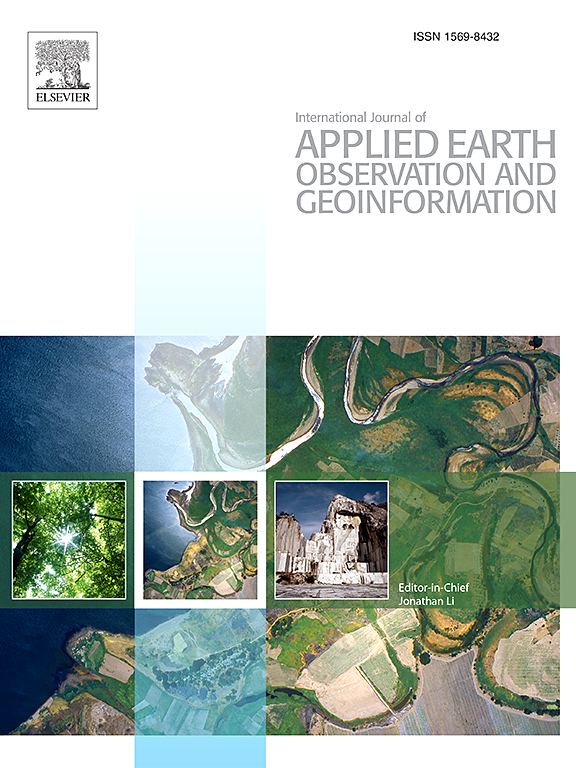Generating high-resolution DEMs in mountainous regions using ICESat-2/ATLAS photons
IF 7.6
Q1 REMOTE SENSING
International journal of applied earth observation and geoinformation : ITC journal
Pub Date : 2025-03-14
DOI:10.1016/j.jag.2025.104461
引用次数: 0
Abstract
High-resolution (≤10 m) digital elevation models (DEMs) are essential for obtaining accurate terrain information and are integral to geographic analysis. However, a majority of currently available DEMs datasets possess a relatively coarse spatial resolution (≥30 m), which limits the terrain features and details that can be accurately represented. Furthermore, due to the substantial production costs associated with high-resolution DEMs, these products are often unavailable or difficult to obtain in numerous countries and regions, particularly in less developed areas. Here, we introduced a novel method named the Spatial interpolation knowledge-constrained Conditional Generative Adversarial Network (SikCGAN). This method can generate high-resolution DEMs from publicly available data sources, specifically the photons collected by the Advanced Topographic Laser Altimeter System (ATLAS) carried by the Ice, Cloud and land Elevation Satellite-2 (ICESat-2). SikCGAN takes ICESat-2/ATLAS photons as the single data source and incorporates spatial interpolation knowledge constraints into a Conditional Generative Adversarial Network (CGAN) to generate DEMs at a 10-m spatial resolution. A case study conducted in boreal mountainous regions demonstrates SikCGAN’s remarkable ability to produce high-resolution and highly accurate DEMs, with an MAE of 22.09 m and RMSE of 29.25 m, which reduced error by 37 %–46 % compared to benchmark methods. Additionally, the results reveal that SikCGAN has remarkable resiliece to interference, including variations in spatial distance, terrain slope, and ATL03 photon count, this further elucidates and substantiates the effectiveness of SikCGAN. These findings demonstrate that SikCGAN provides innovative solutions for generating new high-resolution DEMs products and potentially supplementing existing ones to overcome their limitations.
利用ICESat-2/ATLAS光子在山区生成高分辨率dem
高分辨率(≤10米)数字高程模型(dem)对于获得准确的地形信息至关重要,是地理分析不可或缺的一部分。然而,目前大多数可用的dem数据集具有相对粗糙的空间分辨率(≥30 m),这限制了可以准确表示的地形特征和细节。此外,由于与高分辨率dem相关的大量生产成本,这些产品通常在许多国家和地区无法获得或难以获得,特别是在欠发达地区。本文提出了一种新的空间插值知识约束条件生成对抗网络(SikCGAN)方法。该方法可以从公开可用的数据源生成高分辨率dem,特别是由冰、云和陆地高程卫星2号(ICESat-2)携带的先进地形激光高度计系统(ATLAS)收集的光子。SikCGAN以ICESat-2/ATLAS光子为单一数据源,将空间插值知识约束纳入条件生成对抗网络(CGAN),生成10 m空间分辨率的dem。在北方山区进行的案例研究表明,SikCGAN具有出色的高分辨率和高精度dem能力,MAE为22.09 m, RMSE为29.25 m,与基准方法相比,误差降低了37% - 46%。此外,SikCGAN对空间距离、地形坡度和ATL03光子数等干扰具有显著的恢复能力,这进一步阐明和证实了SikCGAN的有效性。这些发现表明,SikCGAN为生成新的高分辨率dem产品提供了创新的解决方案,并有可能补充现有产品以克服其局限性。
本文章由计算机程序翻译,如有差异,请以英文原文为准。
求助全文
约1分钟内获得全文
求助全文
来源期刊

International journal of applied earth observation and geoinformation : ITC journal
Global and Planetary Change, Management, Monitoring, Policy and Law, Earth-Surface Processes, Computers in Earth Sciences
CiteScore
12.00
自引率
0.00%
发文量
0
审稿时长
77 days
期刊介绍:
The International Journal of Applied Earth Observation and Geoinformation publishes original papers that utilize earth observation data for natural resource and environmental inventory and management. These data primarily originate from remote sensing platforms, including satellites and aircraft, supplemented by surface and subsurface measurements. Addressing natural resources such as forests, agricultural land, soils, and water, as well as environmental concerns like biodiversity, land degradation, and hazards, the journal explores conceptual and data-driven approaches. It covers geoinformation themes like capturing, databasing, visualization, interpretation, data quality, and spatial uncertainty.
 求助内容:
求助内容: 应助结果提醒方式:
应助结果提醒方式:


